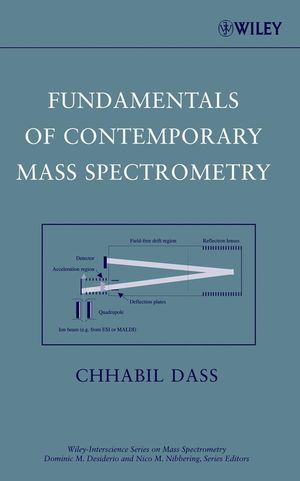Fundamentals of Contemporary Mass SpectrometryISBN: 978-0-471-68229-5
Hardcover
608 pages
April 2007
 This is a Print-on-Demand title. It will be printed specifically to fill your order. Please allow an additional 15-20 days delivery time. The book is not returnable.
|
||||||
PART 1: INSTRUMENTATION.
1. BASICS OF MASS SPECTROMETRY.
1.1. A BRIEF HISTORY OF MASS SPECTROMETRY.
1.2. UNIQUE FEATURES OF MASS SPECTROMETRY.
1.3. BASIC PRINCIPLES OF MASS SPECTROMETRY.
1.4. ANATOMY OF A MASS SPECTRUM.
1.5. ATOMIC AND MOLECULAR MASSES.
1.5.1. Mass-to-charge Ratio.
1.6. GENERAL APPLICATIONS.
1.7. OVERVIEW OF THE CHAPTER.
1.8. EXCERCISES.
1.9. REFERENCES.
2. MODES OF IONIZATION.
2.1. WHY IONIZATION IS REQUIRED?
2.2. GENERAL CONSTRUCTION OF THE ION SOURCE.
GAS-PHASE IONIZATION TECHNIQUES.
2.3. ELECTRON IONIZATION.
2.4. CHEMICAL IONIZATION.
2.4.1. Charge-exchange Chemical Ionization.
2.4.2. Negative-Ion Chemical Ionization.
2.5. PHOTOIONIZATION.
2.6. FIELD IONIZTION.
2.7. METASTABLE ATOM BOMBARDMENT IONIZATION.
CONDENSED-PHASE IONIZATION TECHNIQUES: IONIZATION OF SOLID-STATE SAMPLES.
2.8. FIELD DESORPTION.
2.9. PLASMA DESORPTION IONIZATION.
2.10. SECONDARY-ION MASS SPECTROMETRY .
2.11. FAST ATOM BOMBARDMENT.
2.12. LASER DESORPTION/IONIZATION.
2.13. MATRIX-ASSISTED LASER DESORPTION/IONIZATION.
2.13.1. Analysis of Low Molecular Mass Compounds by MALDI .
2.13.2. Atmospheric Pressure-MALDI.
2.13.3. Surface-enhanced Laser Desorption/Ionization.
CONDENSED-PHASE IONIZATION TECHNIQUES: IONIZATION OF LIQUID-STATE SAMPLES .
2.14. THERMOSPRAY IONIZATION.
2.15. ATMOSPHERIC PRESSURE CHEMICAL IONIZATION.
2.16. ATMOSPHERIC PRESSURE PHOTOIONIZATION.
2.17. ELECTROSPRAY IONIZATION.
2.17.1. Mechanism of Electrospray Ionization .
2.17.2. Sample Consideration .
2.17.3. Nanoelectrospray Ionization .
2.18. DESORPTION ELECTROSPRAY IONIZATION.
2.18.1. DART Ion Source.
2.19. OVERVIEW OF THE CHAPTER.
2.19. EXERCISES.
2.20. ADDITIONAL READING READING READING READING READING READING READING READING READING READING



